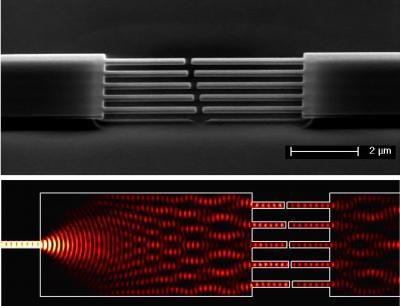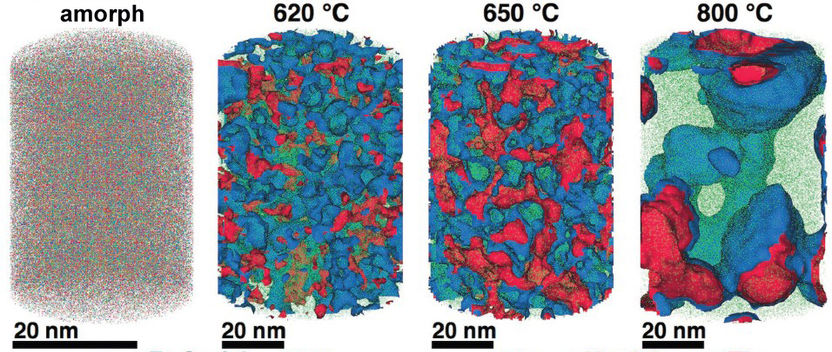Catching the lightwave: Nano-mechanical sensors 'wired' by photonics
As researchers push towards detection of single molecules, single electron spins and the smallest amounts of mass and movement, Yale researchers have demonstrated silicon-based nanocantilevers, smaller than the wavelength of light, that operate on photonic principles eliminating the need for electric transducers and expensive laser setups.

This image shows the electronmicroscopic image of array (top) and simulation of lightwaves through array (bottom).
Li, Pernice,Tang / Yale
The work reported in Nature Nanotechnology ushers in a new generation of tools for ultra-sensitive measurements at the atomic level.
In nanoelectromechanical systems (NEMS), cantilevers are the most fundamental mechanical sensors. These tiny structures - fixed at one end and free at the other - act like nano-scale diving boards that "bend" when molecules "jump" on them and register a change that can be measured and calibrated. This paper demonstrates how NEMS can be improved by using integrated photonics to sense the cantilever motion.
"The system we developed is the most sensitive available that works at room temperature. Previously this level of sensitivity could only be achieved at extreme low temperatures" said senior author Hong Tang, assistant professor of electrical and mechanical engineering in the Yale School of Engineering and Applied Sciences.
Their system can detect as little deflection in the nano-cantilever sensors as 0.0001 Angstroms - one ten thousandth of the size of an atom.
To detect this tiny motion, the Yale team devised a photonic structure to guide the light wave through a cantilever. After exiting from the free end of the cantilever, the light tunnels through a nanometer gap and is collected on chip. "Detecting the lightwave after this evanescent tunneling," says Tang, "gives the unprecedented sensitivity."
Tang's paper also details the construction of a sensor multiplex - a parallel array of 10 nano-cantilevers integrated on a single photonic wire. Each cantilever is a different length, like a key on a xylophone, so when one is displaced it registers its own distinctive "tone."
"A multiplex format lets us make more complex measurements of patterns simultaneously - like a tune with chords instead of single notes," said postdoctoral fellow Mo Li, the lead author of the paper.
At the heart of this breakthrough is the novel way Tang's group "wired" the sensors with light. Their technique is not limited by the bandwidth constraints of electrical methods or the diffraction limits of light sources.
"We don't need a laser to operate these devices," said Wolfram Pernice, a co-author of the paper. "Very cheap LEDs will suffice." Futhermore, the LED light sources - like the million LED pixels that make up a laptop computer screen - can be scaled in size to integrate into a nanophotonic-chip - an important feature for this application.
"This development reinforces the practicality of the new field of nanooptomechanics," says Tang, "and points to a future of compact, robust and scalable systems with high sensitivity that will find a wide range of future applications - from chemical and biological sensing to optical signal processing."
Original publication: Mo Li, W. H. P. Pernice and H. X. Tang; "Broadband all-photonic transduction of nanocantilevers"; Nature Nanotechnology, Published online: 26 April 2009
Other news from the department science
These products might interest you
Most read news
More news from our other portals
See the theme worlds for related content
Topic world Sensor technology
Sensor technology has revolutionized the chemical industry by providing accurate, timely and reliable data across a wide range of processes. From monitoring critical parameters in production lines to early detection of potential malfunctions or hazards, sensors are the silent sentinels that ensure quality, efficiency and safety.

Topic world Sensor technology
Sensor technology has revolutionized the chemical industry by providing accurate, timely and reliable data across a wide range of processes. From monitoring critical parameters in production lines to early detection of potential malfunctions or hazards, sensors are the silent sentinels that ensure quality, efficiency and safety.































































